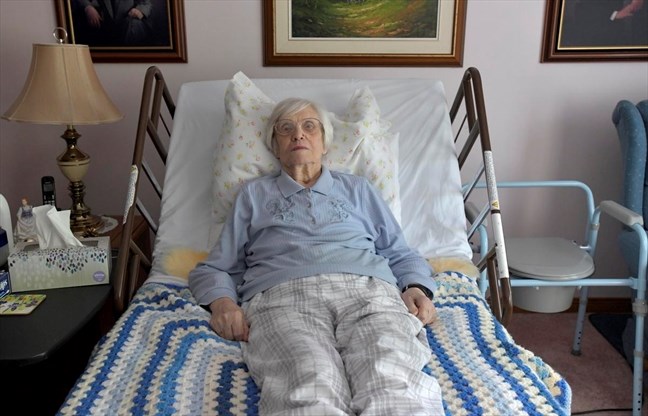The model of bundled care sees different groups of providers band together, share accountability and care for the patient throughout the entire journey.
July 24, 2019 By Joanna Frketich , Grant LaFleche
The Hamilton Spectator and St. Catharines Standard
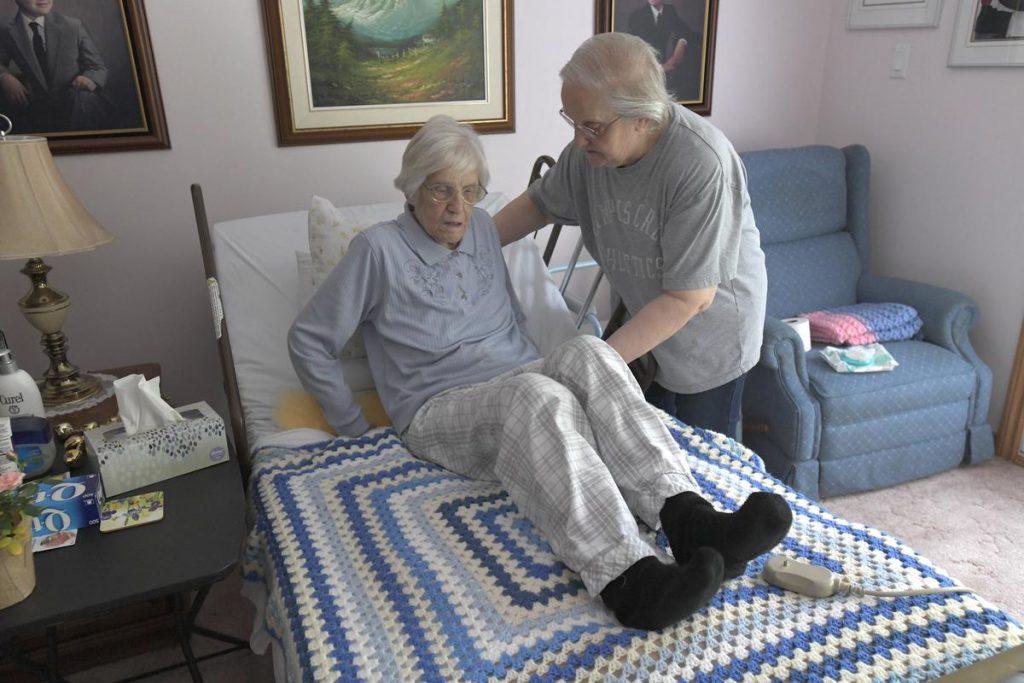
HAMILTON, ON- JUNE 17- Susan Apro helps her mother Pat Coffer, 94, into bed in Apro’s livingroom where Coffer spends 18-20 hours a day sleeping. Coffer was relatively healthy – gardening and walking – until she started having heart issues in April . It’s hard to guess what the journey of patients like Pat Coffer will look like after the Progressive Conservative’s massive health-care restructuring, but the goal is for it to resemble bundled care. bundled care attempts to bridge the gaps that often leave patients lost by never handing the patient off from one service to another, making life for people like 94-year-old Pat Coffer, a little bit easier. June 17, 2019. John Rennison/The Spectator
Something as simple as a phone number has made it doable for Susan Apro to care for her 94-year-old mother at home.
Those 10 digits mean help from St. Joseph’s Healthcare is just a call away for the 70-year-old daughter who is taking on the daunting task of caregiver after her fiercely independent mom, Pat Coffer, developed untreatable heart issues and an aneurysm in April that has left her severely debilitated.
“It means the world to me,” said Apro. “For mom to come home, the burden has all fallen on me … I don’t know what the heck I’m doing.”
The trusted voice on the other end of the line can send a nurse or personal support worker to the East-Hamilton house outside of the usual home-care schedule. Another day, Apro could be asked to send a picture of an emerging bed sore to get instructions on what to do.
“I didn’t have to scramble to get anyone to come into the home,” said Apro. “We can call this number any time.”
Never having to navigate the health-care system alone is the foundation of the highly successful pilot program called bundled care or integrated comprehensive care, introduced by St. Joseph’s in 2012.
“My mom made me promise that she would never go in a nursing home, so as long as I’m able, I’ll keep my mom home, looking after her,” said Apro. “With this program, I have that support behind me.”
It’s hard to guess what a patient’s journey will look like after the Progressive Conservative’s massive health-care restructuring, but the goal is for it to resemble bundled care.
“It is a highly respected model that this plan mimics,” says Donna Skelly, Conservative MPP for Flamborough—Glanbrook. “It has been very successful in Hamilton. It’s a model that we are, in essence, replicating with this new approach to health-care delivery.”
The health-system revamp came into effect June 6 under the Connecting Care Act. An investigation by The St. Catharines Standard and The Hamilton Spectator provides the most comprehensive coverage to date of the overhaul, considered the biggest change since Medicare.
The plan, announced in February, puts a super agency named Ontario Health in charge of the entire health-care system — from hospitals to community care to organ donation to cancer care. It will oversee dozens of regional groups, called Ontario Health Teams, made up primarily of health and social service organizations working together to integrate services locally and help area residents navigate the system.
As the Conservatives undo many of the previous governments’ health-care reforms, primarily local health integration networks (LHINS), there is some irony that a program championed by the Liberals is the prototype for the latest round of health-care restructuring.
Similar to the planned Ontario Health Teams, the bundled care model sees different groups of providers band together, share accountability and care for the patient through the entire journey. There is one pot of money split between all the services, increased use of technology and a navigator to guide patients’ through the system.
“Even family docs have trouble navigating the system,” said Dr. Tom Stewart, CEO of St. Joseph’s and Niagara Health. “We need to make it easier.”
Stewart himself admits he was worried when his father’s lung cancer surgery was scheduled on a Friday at the Hamilton hospital he now leads.
“You’re always a little nervous sending people home on Friday because you’re not sure their home-care team is going to show,” he said. “There is not that point of accountability. It’s a fragmented system.”
Bundled care attempts to bridge the gaps that often leave patients lost by never handing the patient off from one service to another.
Planning starts at admission — or even before for scheduled procedures — so services needed, both in and out of hospital, are pre-arranged and ready to go when needed.
Discharge is not when the patient leaves the hospital but roughly 60 days after going home with one team of providers responsible for the patient’s care from start to finish. The team could include doctors, nurses, physiotherapists, occupational therapists, social workers, dietitians, respiratory therapists, speech and language pathologists and personal support workers. Ideally, the patient meets as much of the team as possible before leaving the hospital.
Most important, there is one point of contact called a care co-ordinator who arranges what’s needed, oversees the care and helps the patient navigate the system.
“We would refer and set up all their services at home,” said Heather Paterson, Niagara Health’s chief nursing officer and director of patient care. “Our care co-ordinator follows (the patient) from hospital to home.”
Patients get a number to call 24-7 where co-ordinators are on standby to stick handle any issues.
Members of the team, such as specialists, can be accessed through technology, which is the type of “virtual visit” recommended by the Premier’s Council on Improving Health Care and Ending Hallway Medicine in its June report as a way to cope with the increasing demands of an aging population.
Stewart’s dad was able to get immediate answers from his doctors without leaving home when there were potential issues with his surgical wound.
“I’m a doctor, and I would have quite honestly said, ‘Go back to emerg,'” said Stewart. “He ends up calling a number and sending a picture of the wound from home with technology, and the doctors say, ‘This is normal. Don’t worry about it.’ That prevents an emerg admission, so you can see how you can start to improve the system.”
Stewart says the program’s three major pillars are one multidisciplinary team, one medical record and one number for patients to call.
The program now stretches from Niagara to Kitchener and has expanded to include chronic lung disease, congestive heart failure, lung cancer surgery, hip and knee replacements, peritoneal dialysis and mental health and addictions. In the fiscal year that started April 1, it is expected to expand to all patients undergoing planned and scheduled surgeries at St. Joseph’s.
So far, 17,000 area patients have received bundled care. Its success was highlighted by the Premier’s Council. Its June report states the program reduced length of hospital stay by 1.26 days on average, reduced costs within 30 days by $2,110 and within 90 days by $3,035.
In addition, 87 per cent of surveyed patients said they felt they were involved and informed in their care.
“The vast majority are saying it’s way better,” said Stewart. “The health-care workers are happier and home-care workers are telling us they feel they can get a nurse or doctor at the hospital easier now, and they feel part of the same team. Caregivers, the patients and their families are a lot more happy.”
St. Joseph’s reports up to a 30-per-cent reduction in emergency visits and hospital readmission rates
At Niagara Health, the readmission rate has fallen to 15 per cent from 19 per cent three years ago, when the program started. The number of patients having to visit the emergency room after discharge also fell over the same period to 32 per cent from 38 per cent.
“By offering the support and building capacity in the community, we are able to manage patients and give them access to care they might not have had,” Paterson said.
It was a lifeline for Apro after her active mom went from gardening and walking to spending most of her time in bed.
She wouldn’t have known where to turn if the program hadn’t arranged for a hospital bed, walker and commode chair to be sent to her house so her mom could live on the main floor. Making it more difficult is that Coffer hasn’t had a family doctor since hers retired.
“My mom has never been sick, and all of a sudden, she’s got these heart issues and she can’t even wash herself,” said Apro. “It’s very upsetting, and it’s a lot of work to take on, but I wouldn’t let anyone else do it.”
The program isn’t perfect. Its major weakness is primary care isn’t involved at all, leaving patients vulnerable after discharge from bundled care.
“There’s got to be that hand off,” said Dr. David Price, head of family medicine at McMaster University. “If you don’t integrate that then they fall through the cracks.”
Bundled care is also too narrow in scope, says Rob MacIsaac president and CEO of Hamilton Health Sciences.
“From my perspective, it doesn’t make a lot of sense to limit it to certain patient populations that are defined by their illnesses,” he said. “I think it would be much better if we could open it up.”
Under Ontario Health Teams, this model would significantly expand to eventually cover all patients and not just those transitioning from hospital to home.
“It will improve patient care by connecting care,” Health Minister Christine Elliott said on a July 18 conference call with health care workers. “People are discharged from hospital, and those people feel like they are shut out of their own health care system and have to fight their way back in.”
She said patients need to know their after-hospital care will continue at home, know how that care works and when and how they can access it.
Even the CEO of the regional network being dismantled by the restructuring thinks patients will be better off in the end.
“While we know these proposed changes will take time, when fully realized, patients, families and caregivers will have access to faster, better and more co-ordinated services,” said Donna Cripps, CEO of the Hamilton Niagara Haldimand Brant LHIN, which includes Burlington.
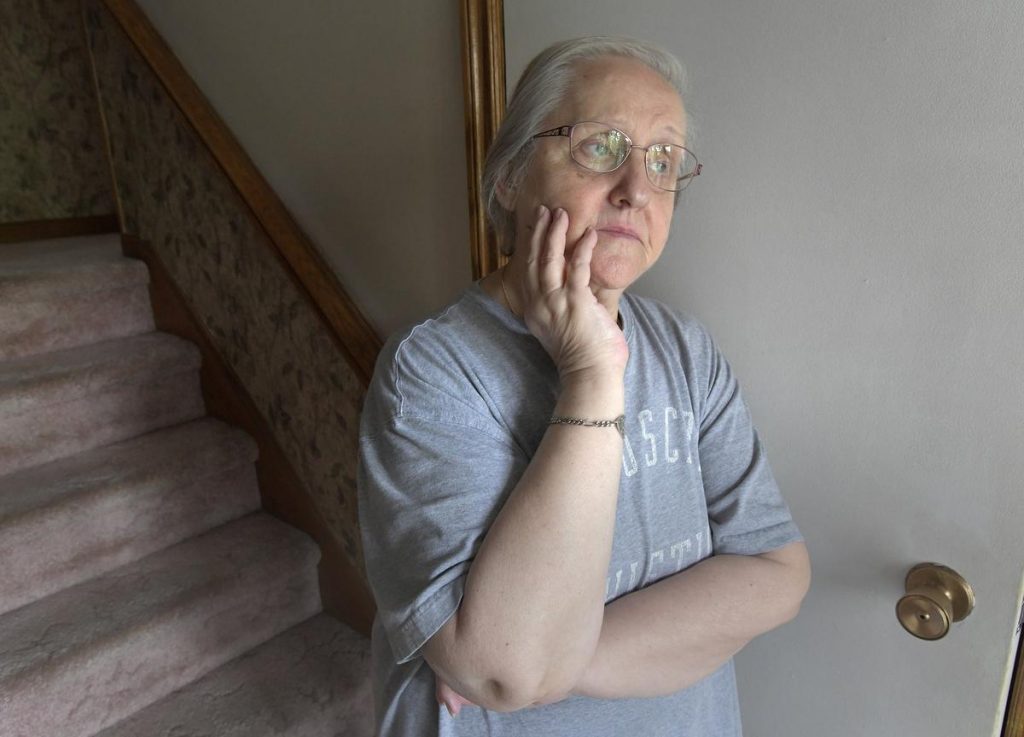
HAMILTON, ON- JUNE 17- Susan Apro has her mother Pat Coffer, 94, living in her livingroom where Coffer spends 18-20 hours a day sleeping. Coffer was relatively healthy – gardening and walking – until she started having heart issues in April . June 17, 2019. John Rennison/The Spectator
It is expected to take years before the monumental changes envisioned by the Conservatives are in place.
“You just can’t change a system as big as health care on a dime,” said Paul Johnson, who is representing the city in the Hamilton Ontario Health Team application.
The government also has to be careful not to disrupt care during the changes.
“It has a lot of promise but, in the meantime, there are going to be things that have to be done to keep the health system functioning while facing some very serious challenges,” said Anthony Dale, president and CEO of the Ontario Hospital Association.
The Ontario Health Coalition worries those pressing issues, like overcrowded hospitals, inadequate home care and shortages of long-term care, will fall by the wayside during the overhaul.
“The whole attention of the health-care system now has turned to restructuring and will be for years,” said executive director Natalie Mehra. “I fear for how long it is going to take to go through all of this.”
It’s expected the health-care changes will happen so gradually that patients won’t ever see a big bang where suddenly the health-care system is turned on its head.
“You won’t notice much of a difference in the first week or month or even the first six months,” said Price. “I hope when we look back in three to five years, we will see difference.”
For the most part, patients will continue to interact with the health-system as normal.
“The message we’re communicating … is business as usual,” said Dr. Ralph Meyer, vice-president of oncology and palliative care at HHS and regional vice-president of Cancer Care Ontario. “We’ll evolve as the system evolves.”
The LHIN says its continuing to do the same work it has always done, even as its board has been dismantled and back-office jobs eliminated.
“Home and community care continues as before, and there are no changes to the long-term care home placement,” said Cripps. “People can continue to contact their home- and community-care providers as normal to access the care they need.”
The Canadian Union of Public Employees (CUPE) says the slow change will be hard for health-care workers, particularly in sectors where their roles are expected to dramatically shift.
“For the people who work for the LHINs, nobody knows really what will happen to them,” said Michael Hurley, president of the Ontario Council of Hospital Unions, which is part of CUPE. “They are expected to soldier on; they are not asked for their input, and they are not valued.”
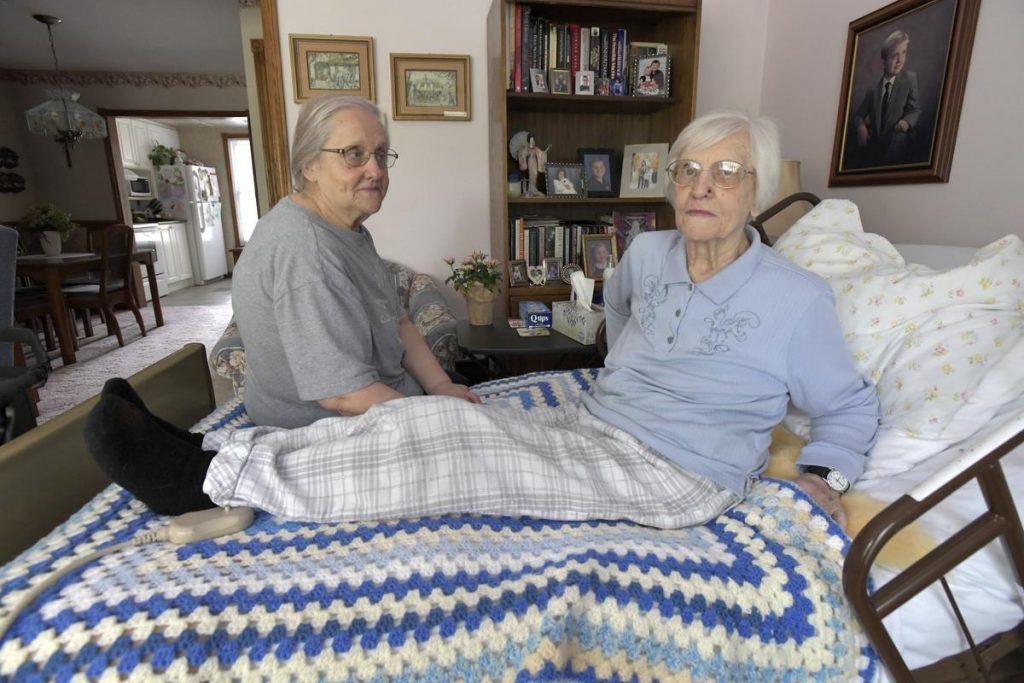
Never having to navigate the health-care system alone is the foundation of the highly successful pilot program called bundled care or integrated comprehensive care, introduced by St. Joseph’s in 2012, which makes it much easier for Susan Apro to care for her mother Pat Coffer. | John Rennison, The Hamilton Spectator
The health-care system is split on how to respond to the changes, with lines drawn between those planning to protest and those hoping to be among the first to adopt the new system.
“We will fight the legislation,” said Mehra. “It’s undemocratic and it’s dangerous.”
The Ontario Health Coalition wants public hearings across the province so Ontarians can have their say.
“The government needs to hear from Ontarians about the real, on-the-ground impacts of what they have created,” said Mehra. “Slow down and listen to people.”
CUPE agrees that the lack of consultation with the public and health-care workers is a top concern.
“I would really appreciate it if this government would stop this process and have a genuine dialogue with people,” said Hurley.
The Ontario Nurses’ Association has started a campaign with the slogan, “Don’t let Doug Ford wreck health care” that urges people to email the premier, the health minister and their MPP.
“This chaotic overhaul of health care is going to take years and cost millions, and there’s no guarantee it will add one single hour of direct care, and it won’t add any of the skilled caregivers who are needed so urgently,” states the campaign.
“The whole attention of the health care system now has turned to restructuring and will be for years. I fear for how long it is going to take to go through all of this,” says Natalie Mehra, the Executive director of Ontario Health Coalition. | Chris Young, The Canadian Press
Unifor had a phone-in town hall for its members about the restructuring and has started a leaflet campaign.
“Wherever we can, we’re going to join in the fight,” said regional director Naureen Rizvi. “People are very angry.
A rally at Queen’s Park April 30 led by the Ontario Health Coalition drew thousands of protesters.
“They’re saying it’s going to be a streamlined system, but I don’t see how they’ve put a model together that actually achieves that,” said Andrea Horwath, Hamilton Centre MPP and leader of the NDP.
On the flip side, Niagara, Hamilton and Burlington health and social service organizations have applied to be early adoptors of the changes by proposing Ontario Health Teams, which are expected to transform the local system. All three groups were informed July 18 that their proposals are moving to the next stage of application.
“In Hamilton, we are in a really good spot to respond to this call,” said family physician leader Price.
Health leaders see it as a logical extension of work that has been going on for years in this area.
“We think we’re ready in Burlington and that we could move forward quite quickly,” said Eric Vandewall, CEO of Joseph Brant Hospital. “We’ve got a lot of enthusiasm around the table and a lot of support for moving forward.”
The province plans to learn from the first Ontario Health Teams to tweak the restructuring as problems are found.
“We have to be looking at these early adopters” said Sue VanderBent, CEO of Hamilton-based Home Care Ontario. “They’re our little petri dish where we try some things and we watch what happens and we learn from that.”
But the experiment really started in Hamilton, with bundled care spreading out over the years to Niagara, Burlington and all of the acute care hospitals in the LHIN and beyond.
“It made a huge difference for me,” said 93-year-old Helen Greves, who got bundled care in February after being released from the Niagara Health cardiac unit in St. Catharines.
While she was part of the program because of her heart condition, bundled care was able to have the flexibility to also look after an unrelated ankle injury from a fall at her Niagara-on-the-Lake home shortly before she went into hospital that has made going out for medical treatment even more difficult.
“Well, at 93 I qualify as elderly, I think,” said Greves. “So I really needed the help.”

Eric Vandewall, CEO of Joseph Brant, says a Burlington mental health partnership has increased access to a wide variety of providers. “We’ve eliminated the feeling patients have about not knowing where to go and being bounced around.” | John Rennison, The Hamilton Spectator
What will your care look like?
No one knows yet exactly what care will look like after the health-care overhaul, but a number of area programs give a potential glimpse of the future.
Joseph Brant Hospital
A Burlington mental health partnership gives patients one point of access to a wide variety of providers so they don’t have to navigate the services on their own. Instead, they are directed to the agency best able to meet their needs.
“Historically we did not operate together,” said Eric Vandewall, CEO of Joseph Brant. “Patients would not know how to access service, which is the right provider, and things were not always timely.”
A second program for chronic obstructive pulmonary disease provides patients with a phone number to call when they need guidance and help navigating the system.
A group for those recovering from hip- and knee-replacement surgery allows patients to do rehab, which would normally be provided at home alone, in a clinic with other patients instead. It’s cheaper, has better outcomes and higher patient satisfaction because it provides peer support and motivation.
“All of this is really about working differently with our community-care providers,” said Vandewall about the various programs. “We’ve increased access, we’ve eliminated the feeling patients have about not knowing where to go and being bounced around, they have timely support, and we’ve been able to reduce wait times significantly.”
Niagara Emergency Medical Services
Non-urgent ambulance calls are visited by Mobile Integrated Health Response Teams in Niagara to connect them with the care they need in the community without going to the hospital.
The teams, made up of EMS and providers in the community, were highlighted in June by the Premier’s Council on Improving Health Care and Ending Hallway Medicine for reducing transports to the emergency department by six per cent for those feeling generally unwell, five per cent for mental health issues and two per cent for falls.
• • •
Operation health care reform: Your guide to the series
The provincial government is undertaking a sweeping overhaul of the health-care system. The changes came into effect June 6 under the Connecting Care Act.
An investigation by The St. Catharines Standard and The Hamilton Spectator provides comprehensive coverage of the health reforms considered the biggest change since Medicare. A four-day, nine-story series looks into all aspects of the plan.
Under the plan, a super agency called Ontario Health will be in charge of the entire system from hospitals to community care to organ transplants to cancer care. It will also oversee dozens of regional groups named Ontario Health Teams that will align health and social service organizations to work together to integrate services and help patients navigate the system.
Hamilton Spectator
July 18/19 by Joanna Frketich
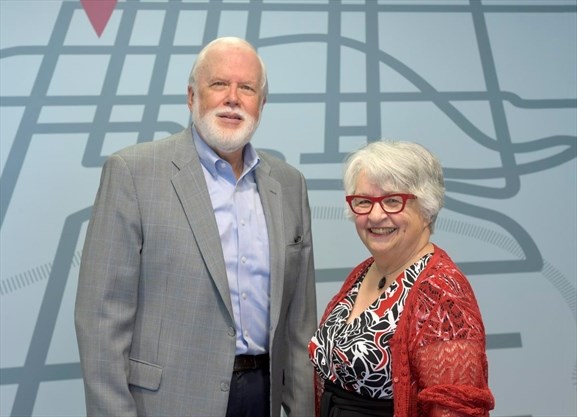
Hamilton Health Team Co-Chairs John Fleming and Bernice King
Hamilton and Burlington organizations want to be among the first to adopt a major overhaul of the health care system by the Progressive Conservative government.
Health and social service agencies have banded together in each city to put forth separate applications to create Ontario Health Teams (OHT), which are expected to oversee dramatic changes in how local care is provided.
Both proposals got the go-ahead Thursday to move to the next stage in the application process to form the first OHTs in the province.
“I don’t think anybody at the table is sitting there because they think the whole thing is broken,” said Paul Johnson, who is representing the city in Hamilton’s proposed health team. “They are sitting at the table because they see such opportunity.”
The legislation for the health system revamp came into effect June 6 under the Connecting Care Act. An investigative series Operation Health Care Reform by The St. Catharines Standard and The Hamilton Spectator starting Saturday (July 20) will provide the most comprehensive coverage to date of the overhaul considered the biggest change since Medicare.
The plan announced in February puts a super agency named Ontario Health in charge of the entire health care system — from hospitals to community care to organ donation to cancer care. The super agency will oversee dozens of regional teams made up primarily of health and social service organizations working together to integrate services locally and help area residents navigate the system.
The Ministry of Health got over 150 OHT applications in May provincewide despite few details being known about how the teams will be governed, funded or operate. The province has said, OHTs will evolve over time based on the experiences of the initial groups.
“This could be the biggest transformation we’ve seen certainly in a long time,” said Johnson. “If we work differently, we can really change the outcomes in terms of better care.”
The Hamilton application is made up of 18 health and social services agencies including Hamilton Health Sciences, St. Joseph’s Healthcare, McMaster University and the city. But there is room for more to join.
“Our principle really is there is an open chair,” said Johnson. “I don’t think any of us are convinced the table is full.”
What makes the Hamilton bid particularly unique is that it is chaired by former cancer patients John Fleming and Bernice King.
“I haven’t been part of too many processes where we really have embedded a patient experience right from the beginning,” said Johnson. “Normally we would get through these first applications and say, ‘You know we really need to find some patients.’ Of course, we’ve decided what we’re doing long before.”
For Hamilton’s OHT application, patients are at the forefront of mapping out a new local health care system.
“It was an opportunity I couldn’t pass up,” said King, who was treated for lung and gynecological cancer.
Both King and Fleming feel this is a chance to give back to the system that helped them when they needed it most and improve it for the next patients.
“I’m here partly because this city and all of its health care systems saved my life literally,” said Fleming who was treated for melanoma. “I’m 100 per cent on board with what is going on and I want to contribute and I want to help.”
He describes their job as being “the relentless conscience of this project to never lose sight of keeping patients at the centre of this.”
The Burlington group also put patients first when it decided to make family medicine the focus of its application with all but two of the eight organizations being primary care providers.
“Our team recognizes the importance of primary care as the foundation of the health care system and that’s why I agreed to sign up for it,” said family physician Dr. Harpal Singh, who is the co-chair of the proposed Burlington OHT. “We feel this kind of model really should be the model of care throughout Ontario.”
So far the proposed Burlington team accounts for 60,000 rostered patients but it’s also hoping to grow.
“We’re still trying to get the word out to physicians in Burlington,” said Singh, lead doctor at the North Burlington Medical Centre Family Health Group. “Due to privacy laws we’re not even allowed to have access to physicians’ emails without their permission. These are the kinds of barriers that inhibit care for patients.”
Teams being considered to form the first OHTs have been asked to put in a full application to represent a geographic area with a population up to 500,000. The early adopters will be announced in the fall.
Both Hamilton and Burlington groups are confident they will be among the first OHTs because health and social service organizations have long collaborated in this area.
“Why I think we’re a bit optimistic is that we’ve put the work in prior to this,” said Johnson. “This really builds on work that’s been going on in Hamilton. We’ve been thinking about what health care means in the broadest sense of that term from the social determinants of health umbrella.”
One of the reasons Hamilton is so far ahead is an ongoing project started in 2010 by The Spectator called Code Red that found glaring disparities between neighbourhoods in Hamilton including a 21-year difference in average age at death. It long ago helped foster ongoing collaboration between health and social service agencies.
Johnson gives the example of the patient with chronic obstructive pulmonary disease who ends up in the emergency room four to five times every summer because the progressive lung disease is exacerbated by heat.
“This primary care physician is saying it would be great if they had an air conditioner and I say we have a program that could deliver an air conditioner,” said Johnson. “Those are the little things.”
The OHTs will aim to bridge the gaps that often leave patients lost by having multiple providers band together to take joint accountability for the entire journey through the system.
“I often look around and think we have it all here,” said Johnson. “What is holding us back is the inability to do the things we know we need to do. Sometimes that is because we don’t have the relationships with each other to even know someone else could do it. We’re a bit discoordinated.”
Drastically changing how health care providers interact is the only way the system will be able to cope with the growing and aging population, says Singh.
“Healthcare often is relatively insatiable in the amount of expectations that we have,” said Singh. “In order to work with limited resources we need to organize ourselves better.”
Joining the OHT requires a leap of faith considering neither group has come up with a governance structure yet or knows what will happen to their funding when the province provides one envelope of cash per patient to be shared among all the services.
“We’d be naïve to say everybody around the table is not thinking about that,” said Johnson. “When people already have a bit of a relationship — believe me it’s not all kumbaya moments — there is at least that level of trust that we are going to continue to work at this and even if it’s not perfect yet we’ll keep making it better.”
There’s no startup funds so the organizations involved have to find a way to pay for the costs of the application and the administration of the proposed OHT.
“There is no pot of money being offered by Queen’s Park,” said Fleming. “It’s figure out how to put this together within the resources of our team.”
In addition, the OHT has to navigate making sure small organizations in the group get a voice when massive players like HHS, St. Joseph’s and Joseph Brant Hospital are involved.
“There are physicians in Burlington who have felt that the hospital has their agenda and family doctors have their agenda and they don’t necessarily align,” said Singh. “We work in that fragmented and siloed way and it becomes really increasingly difficult for patients to get proper care or to negotiate through that system.”
Both groups say they won’t quit even if they aren’t chosen to be among the first teams.
“Whether we are an early adopter or not, our position has been that we are going ahead at the same pace that we have been to date, this is such important work.” said Dr. Cheryl Williams, co-chair of the proposed Burlington OHT and executive vice president clinical at Joseph Brant.
Her co-chair Singh expects the province to keep working with teams not initially chosen until they are ready to become an OHT in future waves of the roll out.
“Our plan to co-operate, break down barriers and provide the best kind of care for our patients is going to move forward,” he said. “It’s just going to get stronger.”
Article: The Toronto Star | Reporter: Theresa Boyle | March 2, 2019
A week after having part of a cancerous lung removed, Grant Lewis grew concerned that the incision wound on his chest had become infected.
The 54-year-old Beamsville construction worker dug out a phone number he had been given when he was discharged from hospital. Call it any time, day or night, if you run into trouble, he was told.
Lewis dialed the number and was connected to his nurse, Anna Tran, at St. Joseph’s Healthcare in Hamilton. On her advice, he used his mobile phone to snap a photo of the inflamed and seeping lesion, and then emailed it to her.
Almost 40 kilometres away, Tran looked closely at the image on her cellphone. She then forwarded it to the home-care arm of St. Joe’s, along with an email requesting that Lewis be seen that same day for wound care.
Within hours of placing the call, Lewis answered a knock at his front door. It was a visiting nurse. She cleaned his wound, changed the dressing, and then updated his medical record on her tablet computer.
Tran and the rest of Lewis’ care team at St. Joe’s all had access to his electronic medical record. The home-care nurse’s update assured them all he did not have an infection and was recovering well.
This little scenario, which took place in January, provides a glimpse into the future of health care in Ontario, as Health Minister Christine Elliott envisions it.
The sectors have a reputation for being siloed. The weakest parts of the health system are the transfer points between them. Hand-offs can be bumpy and patients can fall between the cracks.
Requisitions for ongoing services don’t always get passed along in a timely fashion. Sometimes it seems like they don’t get passed along at all.
Patients, still feeling unwell, can be left to navigate their own way through the Byzantine health system, which is a world unto itself with a seemingly foreign language full of acronyms and jargon.
Because Ontario is not as far along as it could be when it comes to electronic medical records, it can take days for updates to get transmitted between providers. When care is delayed, patients’ health can deteriorate, families can panic and unnecessary trips can be made to the emergency department.
Elliott told a news conference that the overall intent of her plan is to make the system easier for patients to navigate by “seamlessly” connecting sectors and making greater use of digital tools.
Critics of the government’s plans say they are overkill and are worried that the health system could be destabilized while “radical” changes are made. That has been the experience of other provinces that have gone this route, they note. They argue that this much change is not necessary for the Conservative government to make good on election campaign commitments to end hallway medicine, open more long-term care beds and create more mental health and addiction services.
Following Elliott’s Tuesday announcement, the Star followed up with her office to get a better idea of what her reform plans would look like on the ground. It was suggested we take a look at St. Joseph’s Healthcare in Hamilton, specifically at its Integrated Comprehensive Care (ICC) program in which Lewis was a patient.
The program started as a pilot back in 2012. Known then as the “bundled care” program, it was designed to connect surgical patients with a single team of clinicians who could care for them before, during and after their operations.
To date, more than 17,000 patients have gone through St. Joe’s ICC program. In addition to thoracic surgery patients such as Lewis, they include patients who have had hip and knee replacements, suffered from chronic obstructive pulmonary disease and heart failure, undergone cardiovascular surgery and been on peritoneal dialysis.
It has resulted in a savings of up to $4,000 per patient, a 30 per cent reduction in emergency department visits and 30 per cent reduction in hospital readmissions, a savings of more than 30,000 bed days and an increase in patient satisfaction, according to the hospital.
St. Joe’s is in the process of expanding it to all surgeries and some ER patients. There are plans to further expand it to mental health and long-term care patients, and to frail seniors in their homes.
Elliott would like to see this type of program emulated across the province.
“Patients should be fully supported when returning home from the hospital and be connected to home-care services right away. A connected and co-ordinated system is our vision for a patient-centred health-care system,” she said in a written statement provided to the Star.
“The integrated-care model at St. Joseph’s Healthcare in Hamilton is a prime example of the important work that can be achieved when health care is centred around the patient,” her statement continued.
Lewis said he was very pleased with the care he received. Any concerns he had were immediately addressed and he felt confident he was in good hands, he said in a phone interview.
Best of all, he only had to stay in hospital for three nights, he noted. Assurances of good, ongoing care at home allow for quicker discharges.
“I wanted out. I am much more comfortable and relaxed in my own place,” Lewis explained
He had “virtual” followup appointments with Tran, an ICC co-ordinator and Lewis’ main point of contact in the program. Through Skype and a specially designed app, they could have face-to-face conversations, using cellphones, tablets or laptop computers.
The program has been a success with caregivers such as Lewis’ wife Nancy who said she appreciated the immediacy of it: “When you are in a hospital bed and you need help, you press a call button. That’s what this app is like. Anna Tran, someone with so much knowledge, is right there.”

